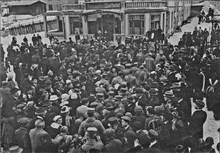Prisoner of war camps in Switzerland during World War I
To be transferred the wounded had to have a disability that would negate their further military service or interned over 18 months and deteriorating mental health.
Only the following illnesses could lead to departure from Germany: diseases of the circulatory system, serious nervous problems, tumours and severe skin diseases, blindness (total or partial), serious face injuries, tuberculosis, one or more missing limbs, paralysis, brain disorders like paraplegia or haemiplegia and serious mental illnesses.
[5] [6] The Red Cross helped initiate these internments, which it proposed at the end of 1914 and were implemented starting in February 1915.
Approval for departure in no way meant permanent freedom but instead transfer to Konstanz, where a medical commission verifying the prisoners' state was located.
At the beginning, meals were a great improvement on camp offerings: "Morning, 7 o'clock, we had café au lait, jam, and 225 grams of bread for the day.
[10] In order to relieve the pressure on Switzerland, from the middle of 1917 British and German prisoners also began to be interned on similar terms in the Netherlands.

